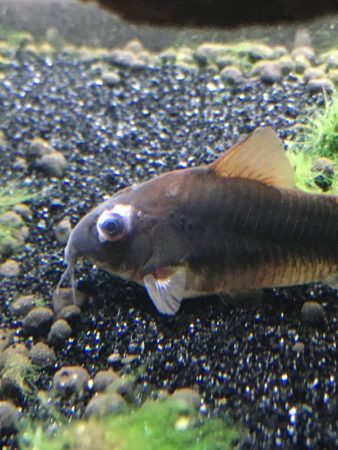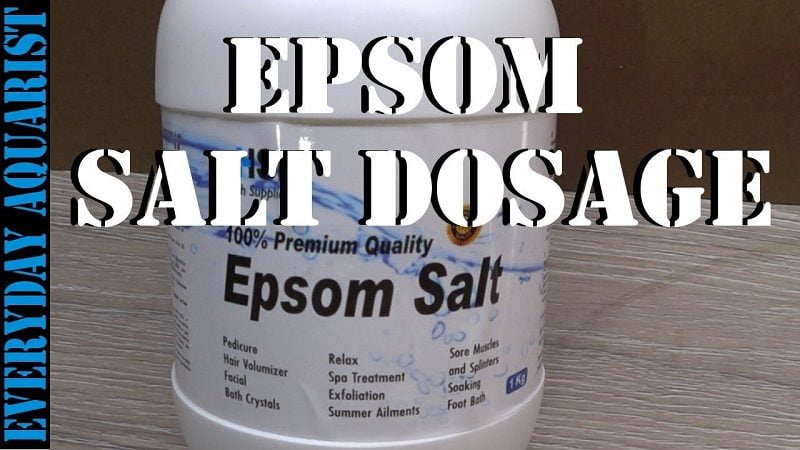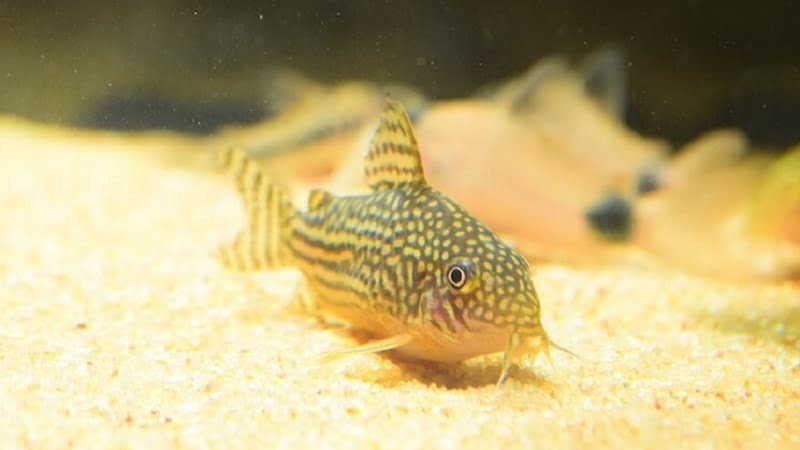Cory catfish eyes bulging is also called the “popeye” in catfish. If this symptom is in a severe state, your cory catfish will lose their sight.
This article will give you the cause of cory catfish eyes bulging or popeye disease, what treatments should be taken and what protocol should be followed to prevent this.
Causes Of Cory Catfish Eyes Bulging – Popeye Disease
Eyes bulging in cory catfish usually refer to popeye – a common eye problem in aquarium fish and a symptom of underlying infections and diseases. The medical term for this eye problem is Exophthalmos.
The bulging eyes in cory catfish can be either unilateral or bilateral, meaning this can affect one or both eyes of your fish. Unilateral popeye is commonly caused by physical damage to the fish, whereas bilateral popeye is often a reaction to poor aquarium water conditions.
The causes of popeye in catfish often include trauma resulting in physical injuries, internal swelling, infections, and poor water quality.
Physical injuries
Fish usually do not have eyelids, so their eyes are sensitive and easily get injured when bumping into tank decorations or other fish in the aquarium. It is especially true if one fish exhibits popeye in a community aquarium.
Your fish may have scraped its eye against abrasive objects in the tank or fought with another fish, resulting in a swollen eye.
In most cases, when physical injuries cause the popeye, the protruding portion will gradually recede as soon as the eyes heal. It is still necessary to closely monitor the fish because eye infections can occur, leading to blindness in the injured fish.
Infections
Different types of organisms, including bacteria, fungi, and parasites, are capable of causing infection.
Often, infection-induced popeye will affect both eyes rather than only one eye in your cory catfish. Swelling behind the eye can occur in fish suffering from some other diseases, like dropsy. When you notice your cory catfish have bulging eyes and dropsy, your fish is probably seriously infected.
It may be hard to detect popeye caused by an infection at first, but gradually this condition worsens. One of your fish may be affected initially if there are multiple in your tank but the infection will soon spread to other fish mates.
Poor water quality
Poor water quality and stress in cory catfish are closely related. Poor water quality probably results in severe stress for your fish, significantly reducing their immune systems and their resistance. As a result, your cory catfish are vulnerable to infections, contributing to initiating popeye condition.
Thus, if you notice cory catfish eyes bulging, test your water to find out if something is wrong with the water chemistry. Be aware of gas supersaturation in the water, which is visible as bubbles on the sides of the aquariums and even on the fish’s skin, since gas can accumulate in the fish’s eyes and result in swelling.
Internal issues
The problem of cory catfish eyes bulging can also result from internal problems, such as kidney failure or a metabolic issue, or tuberculosis, because these problems cause the fluid to build up in their body.
Like other freshwater fish, the cory catfish’s gill and kidney play an important role in removing excess water that they have taken in. If their kidneys or gills malfunction, the body will store water, resulting in surplus moisture. The fluid can accumulate in the tissues behind the eye, causing it to stick out.
Identifying and correcting the cause of kidney or gill dysfunction is crucial before treating popeye because eye bulging is a secondary clinical sign.

Cre: Titanium_Tod on Reddit
Signs Of Bulging Eyes In Cory Catfish
It can be difficult to detect popeye in fish before it causes significant damage, as its early signs are subtle. Here are some possible symptoms of the popeye condition in your cory catfish.
Bulging on one or both eyes
Initial protrusion of the eye is usually slight in one or both eyes. A fluid bag may also appear behind the affected eye as the condition progresses. At this stage, the eyesight of your cory fish is not affected yet, so it will continue swimming around normally.
Eyes appear cloudy or discolored
Discoloration of one or both eyes is also a sign of popeye. Especially, the eyes of a fish suffering from popeye could appear cloudy and milky. However, a discolored eye may also signify other problems and diseases in cory catfish, especially if swelling is not accompanying it.
Eyes appear bloodstained
Some fish suffering from popeye will also have bloodstains in the affected eye in addition to protrusion. These bloodstains typically occur due to extreme eye swelling because a huge volume of fluid behind the affected eye ruptures the blood capillaries in the region. In some cases, blood infiltrates the cornea, making their eyes look like being bleeding.
The eye is ruptured or falls out of its socket
Uncontrolled swelling of the fluid bag behind the eye can lead to large swelling and high pressure. The pressure eventually becomes too much, causing the eye to rupture (pop out of its socket). The eye may not be able to be saved if popeye has reached this point. Proper treatment and care will improve the chances of recovery, but their eyes will remain blind.
Behavior changes
If your cory catfish have popeye, their behavior will also change, for instance, they might try to hide most of the time. Even their appetite may be affected, resulting in them not eating and losing weight. However, you will see that their bodies got swollen up and their swimming is abnormal.
Treatment For Cory Catfish Eyes Bulging
Physical trauma
In general, the treatment for cory catfish eyes bulging from a physical injury, by fighting or accidentally bumping into decorating rocks or woods, is easier and has a higher probability of success than the condition caused by bacteria-related problems.
The best treatment for a fish that has been traumatically injured is good water quality, a nutritious diet, and removing the cause of the injury, if possible.
Salt baths using Epsom salt usually successfully treat cory catfish eyes bulging from physical injuries.
- Add some tank water to a small container.
- Follow the dosage instructions on the packaging when adding Epsom salt to the container of water. It is usually one tablespoon per 5 gallons of water for a minimum of three days and can be longer if necessary.
- Pour the Epsom salt into the water and stir until it dissolves, and then carefully place your cory catfish into the container, and leave them there for about 10 minutes.
- The water temperature in your cory catfish’s bath should be the same as the temperature in his aquarium. Float the container in the aquarium while he is in the bath to maintain this temperature.

Infections:
- You should move the infected fish into a hospital aquarium if the popeye was caused by an infection. The infection can be treated with a broad-spectrum antibiotic recommended by your veterinarian or pet supplier. Some of the recommended ones are ‘Maracyn’, ‘Maracyn II’, ‘eSHa 2000’, and an anti-internal bacteria.
- You may want to consider treating the entire aquarium if multiple fish are displaying signs of illness. To be safe, use an all-purpose antibiotic and improve the water quality.
- Lastly, high-quality food is important for supporting your fish’s immune system.
- Serious cases of popeye may require several months of treatment, so it is important to make sure the water conditions continue to be monitored.
Internal swelling
If your fish’s kidneys or gills are not functioning properly, you will have to correct the issue. Initially, you should check the water parameters to ensure your water chemistry is in the correct range. If any of the parameters are out of range, make plans to correct them. Be sure to correct any pH and temperature issues slowly! When water quality isn’t the issue, contact a professional to solve the problem quickly and effectively.
Poor water quality
Good water quality is one of the most important points of successful treatment.
Firstly, you should take all infected fish to another tank with optimal water parameters and start the treatment.
In the main tank, to disinfect the water, you should test the water in the tank. Once high ammonia and nitrate levels are detected, you need to manage this immediately by doing water changes until these parameters are in the correct range.
Prevention For Cory Catfish Eyes Bulging
Why cory catfish eyes bulging is a serious problem?
Cory catfish with bulging eyes become less active and do not show any interest in food. In some cases, fish with unilateral popeye disease can still survive after losing sight in one eye, but it will negatively impact their quality of life. The fish can die if this disease is not detected soon after being caught. Taking care of the fish will become more difficult if they become blind.
In addition, the popeye condition is usually accompanied by other health problems. A weakened immune system can make the fish more susceptible to opportunistic bacteria or fungal infections. Septicemia is responsible for most cory catfish deaths from uncontrolled popeye issues, as it can cause organ failure in different parts of the body.
Prevention
Popeye can be prevented simply by providing fish with a healthy aquarium environment to limit the stressors that can weaken their immune system. By taking steps to minimize the risk of physical damage, you can also reduce the occurrence of bulging eyes in your cory catfish.
- Remove dangerous tank decorations: Tank decorations, such as plastic plants with sharp leaves or sharp-edge woods, may threaten your cory catfish. Thus, you need to remove such decorating objects.
- Quarantine new fish: It is a good idea to quarantine new fish, invertebrates, or plants for a couple of weeks before adding them to your main tank. You can introduce all your livestock to your main tank after you are sure they are healthy.
- Perform well tank maintenance: If the water is changed periodically and the fish are fed with a sufficient-nutrient diet, the risk of a popeye strike is significantly diminished. It is also crucial to avoid overstocking and overfeeding your fish.
- Avoid clumsy handling: Clumsy handling can easily damage cory catfish eyes owing to the lack of eyelids. Avoid using coarse or abrasive fish nets, and use nets to drive fish into plastic containers rather than to trap them directly.
- Adjust aquarium lighting: Sudden lighting changes in the aquarium can cause the fish to be nervous and easily get injuries from bumping into the tank side or other fish, especially for the aquarium in a dark room lacking natural lights. Thus, before turning on the aquarium lights in a dark room, turn on the room’s lights for a few minutes. In the evening, do the opposite – leave the room’s lights on for a while, after turning off the aquarium light.
Video: Treating Popeye In Aquarium Fish Fast!
FAQs
Is popeye contagious?
Other fish would not be affected by popeye if it was caused by physical injury. It can be contagious and spread throughout the tank if it is caused by a parasite or bacterial infection.
Is popeye fatal?
Cory catfish influenced by popeye can recover well if noticed early and treated accordingly.
When the condition reaches extreme levels, it can rupture the affected eye, making your fish permanently blind and even leading to death by severe internal infections.
Does Melafix treat cloudy eyes?
API MELAFIX is an effective solution for bacterial infections like fin & tail rot, eye cloud, popeye, and body slime. So, the answer is yes, this product can be used to treat cloudy eyes in your fish.
Conclusion
Physical injuries and bacterial infections are possible causes of cory catfish eyes bulging. This could even be due to an internal problem in your fish, such as tuberculosis. To effectively treat this popeye condition, you should determine the cause, ensure stable water parameters, and apply proper treatment. After all, it is advisable to watch closely to ensure a secondary infection does not take hold and progress extremely.

Annette M. Chaney is an experienced marine biologist with over 20 years of experience as an aquarist and fishkeeper. She started her first aquarium at a young age, filling it with frogs and goldfish obtained from the ten-cent pet store.
Annette grew up caring for and breeding African Cichlids, which led to a hobby in high school that doubled as a profitable means. Attending Reed College gave her time to solidify herself as an accomplished aquarium caretaker with an eye for sales. After that, from 2009 – 2013, she studied at Roger Williams University – one of the most prestigious universities for Aquaculture and Aquarium in USA. She is the founder of AquariumCircle since 2010.
